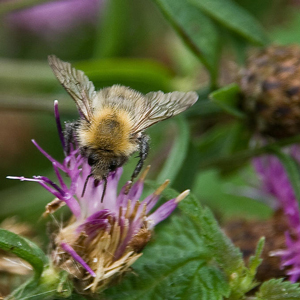More of Our Bees Are in Trouble
By Chris Williams on February 27, 2014.
 In the last few years, you have no doubt seen news items about the slow demise of honey bees due to a syndrome called Colony Collapse Disorder (CCD). Entire colonies of bees are dying off and no one yet knows exactly why (see Honey Bee Colony Collapse Disorder). As if it wasn’t bad enough that we are losing these valuable pollinators, now scientists have discovered that the related bumble bees are suffering from what appears to be the same set of problems.
In the last few years, you have no doubt seen news items about the slow demise of honey bees due to a syndrome called Colony Collapse Disorder (CCD). Entire colonies of bees are dying off and no one yet knows exactly why (see Honey Bee Colony Collapse Disorder). As if it wasn’t bad enough that we are losing these valuable pollinators, now scientists have discovered that the related bumble bees are suffering from what appears to be the same set of problems.
The latest report from government scientists concluded that the CCD affecting honey bees appears to the result of a combination of poor nutrition, the parasitic Varroa mite, various new viruses that are attacking weakened honey bees, and a lack of genetic diversity among hives. All of these factors are apparently able to combine together and produce the perfect storm largely because pollination has become big business. In commercial pollination sales, bee hives are trucked from farm to farm, or orchard to orchard to pollinate crops. Perhaps the industrious honey bees are being worked to death.
Many people don’t realize that honey bees are not the only pollinators; they just get all the press. There are 3,500 other kinds of bees in North America that are collectively called “pollen bees.” This group includes ground-nesting solitary bees that don’t live in colonies. Examples include digger bees, mining bees, leafcutter bees, sweat bees, and bumble bees.
Honey Bee Diseases are Also Killing Bumble Bees
The large, fuzzy black and yellow bumble bee is easily recognizable and is one of the best wild pollinators of both wildflowers and crops. Honey bees are still the top dogs, pollinating about $20 billion dollars worth of fruits and flowers each year, while bumble bees contribute about $3 billion worth in pollination.
Bumble bees around the world have been suffering decline; some species in Europe have gone extinct. Studies have shown that bumble bees are suffering from the same diseases as honey bees, and bumble bees seem to be hit even harder by the diseases than honey bees. Wild bumble bees live 21 days on average, but infected bees live only 15 days. Bumble bee hives are much smaller than honey bee hives so the hives are more seriously affected.
As you can imagine, researchers are frantically trying to find out how and why bumble bees are picking up honey bee diseases. Wild bumble bees are not trucked from crop to crop. Instead, the bees seem to be suffering from a spillover of parasites and pathogens and disease from commercial honey bee hives. The bumble bees probably pick up the diseases when they visit flowers that have just been visited by infected honey bees. Bumble bees are also known to invade honey bee hives to steal nectar, and may become infected that way. Experts say that controlling diseases in commercial honey bee hives is vital to stopping the spread to wild bumble bees and perhaps other pollen bees, as well.
Photo credit: Jack Picknell / Foter / CC BY